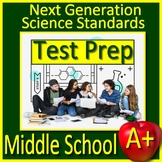6th Grade Earth Science NGSS Worksheets - Student Packet
- Zip
- Google Apps™
- Internet Activities

What educators are saying
Also included in
- Next Generation Science Test Prep: This HUGE bundle has EVERYTHING you need to cover the new Next Generation Science Standards for Middle School. ALL NGSS standards are covered using a variety of learning tasks. Perfect for test prep practice and NGSS spiral review. ALL of the practice tests are wrPrice $42.00Original Price $82.00Save $40.00
- Are you looking for Google Ready materials to cover 6th Grade Science for the full year? This test prep bundle contains learning packets, assessments, games, and task cards that cover ALL of the NGSS 6th grade science standards. All of the materials are printable AND Google Ready for Google ClassroPrice $15.75Original Price $26.50Save $10.75
Description
Earth Science Independent Work Packet - This is a student packet that covers Earth Science for the Next Generation Science Standards (NGSS). It includes 20 question and answer activities (short answer, scientific order, multiple select, etc.).
The packet is completely printable, but Google LINKS are also provided for use in Google™ Classroom for remote learning. Perfect for at home distance learning (elearning). Both versions are included with your purchase. Students use Chromebooks, Ipads, Laptops, Desktops, etc.
Covers:
Earth's Place in the Universe
Earth's Systems
Earth and Human Activity
Includes:
--Printable Copies
--Student Packet with 20 questions and answers
--Step by Step Directions for putting the packet in Google Classroom, and sharing with your students for distance learning.
--The Google Docs are completely editable to suit your needs.
Question Types:
Short Answer, Multiple Select, Scientific Order, Fill in the Blanks
BUYER’S NOTE: This packet is set up as a review after the subject matter has already been taught. It does not contain the source material. The Google docs are written in editable format so the buyer has the opportunity to revise the questions to reflect individual curriculum.
Next Generation Science Standards
Why am I qualified to write these science activities? Not only have I worked as a teacher for 30 years with a Highly Qualified Status, but I also have spent 15 years writing state and national assessments, such as the SATs, ACTs, and individual state assessments that align with the Next Generation Standards. This includes grading, item writing, and passage writing for these assessments.
Helpful for: NECAP STEP TCAP MSP WKCE PAWS CCSS PARCC, SC Ready, Smarter Balanced, SBAC, MCA, MCAS, LEAP 2025, ITBS, TerraNova, PSSA, NC EOG, NC Ready TNReady, ILEARN, Ohio’s State Test OST, Oklahoma State Test (OSTP) IAR, NJSLA, NWEA MAP, MCAP, STAAR Science Test Prep CMAS, IAR, CAASPP, MCAS, Engage NY, ACT Aspire, Georgia Milestones
The 26 states involved in developing the NGSS, called Lead State Partners, were Arizona, Arkansas, California, Delaware, Georgia, Illinois, Iowa, Kansas, Kentucky, Maine, Maryland, Massachusetts, Michigan, Minnesota, Montana, New Jersey, New York, North Carolina, Ohio, Oregon, Rhode Island, South Dakota, Tennessee, Vermont, Washington, and West Virginia.







